About the Trees
Pōhutukawa and rātā are known as New Zealand’s native Christmas tree because of the bright red blooms which decorate the trees during the Christmas season. They trigger memories of long summer days spent with friends and family in, on, around and under these magnificent trees.
Pōhutukawa and rātā belong to the myrtle family (Myrtaceae) which is made up of about 3000 different tropical and warm temperate trees, shrubs and vines. Eucalyptus, feijoas, cloves, guavas and bottlebrushes are a few family members.
In New Zealand myrtles are represented by some of our best known plants: kanuka, manuka and some less familiar, but nevertheless significant species like swamp maire and ramarama.
Both pōhutukawa and rātā belong to the genus Metrosideros, the iron hearted myrtles, a reference to their hard, very heavy, dark red heartwood.
There are two native pōhutukawa (mainland and Kermadec) and six species of rata vine, a shrub and three tree rātā.
Project Crimson concentrates on the mainland pōhutukawa and the tree rātā – northern, southern and Bartlett’s – as these are the most threatened by possums and people.
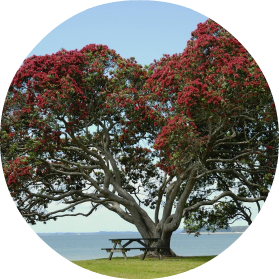
How fast do the trees grow?
Young plants grow faster than older plants. In a very fertile environment with good moisture and plenty of room, young pōhutukawa grow at around 30cm per year in height and 5-10mm in diameter (thickness). Older trees gain around 10cm in height a year and 2mm in diameter. Rata grows at about half the rate of pōhutukawa.
How long do they live?
Pōhutukawa can live for hundreds of years in their natural coastal environment. While it is common to see 100-year-old trees growing in home gardens, both pōhutukawa and northern rātā can probably live up to 1000 years.
Both pōhutukawa and southern rātā can spread by branches that touch the ground sending out roots and forming new trees. As a result it is impossible to accurately assess the age of trees that have grown in this manner.
The Species
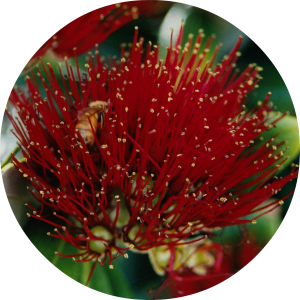
Mainland Pōhutukawa
Metrosideros excelsa
Metrosideros excelsa
Metrosideros is the Greek word for ironwood, which reflects the hard nature of the timber. The species name excelsa is derived from the Latin word meaning “raised” or “exalted”. A former name, Metrosideros tomentosa, described the felt of white hairs (tomentum in Latin) which covers young stems, buds and undersides of the leaves.
Found throughout the North Island, particularly north of New Plymouth and Gisborne. Pohutukawa grows best in warm, drier areas close to the sea. Grows to 20 metres high by 35 metres wide.

Northern rātā
Metrosideros robusta
Metrosideros robusta
Found from Hokitika northwards. It usually begins life as an epiphyte (perching plant) high in the forest’s canopy. The largest trees are found in warm moist areas such as northwest Nelson and Northland. Northern rata grows from the coast to a maximum of 900 metres above sea level.
One of New Zealand’s tallest flowering trees. Grows to 25 metre or more high with a trunk up to 2.5 metres in diameter.
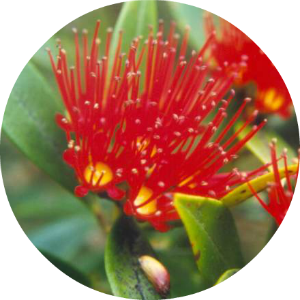
Southern rātā
Metrosideros umbellata
Metrosideros umbellata
Grows throughout New Zealand, particularly along the South Island’s West Coast. Best suited to South Island and cooler, high rainfall regions. Occurs from sea level to 760 metres above.
A forest tree, it is found on rocky slopes and in river gorges from coast to mountain in the south and west of the South Island. It is restricted in the North Island to isolated stands or single trees on elevated cool damp sites.
Grows to 15 metre high – sometimes more – with a trunk up to 1 metre through. Considered to be an ancient species from which northern rata and pohutukawa evolved.
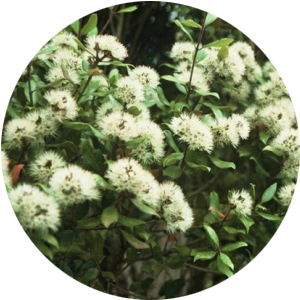
Bartlett’s rātā
Metrosideros bartlettii
Metrosideros bartlettii
Discovered in 1975 as a small, isolated population at the northern tip of the North Island. Rātā moehau (Bartett’s rata) is critically endangered with very few adult trees remaining in forest remnant near Cape Reinga.
Trees grow up to 20 metres high by 6 metres wide and have a bark similar to that of the paper-bark myrtles in Australia. They usually develop as perching plants in the canopy of the host tree.
Roots are formed and eventually reach to the ground, coalescing into a single trunk which in due course replaces the host.
Did you know?
- Rātā that germinate on the ground grow into trees that look different to rata that germinate high among the branches of a host tree.
- The trunk of an epiphytic rātā consists of coalesced roots coming down from above, whereas the trunk of a terrestrial rata consists of a stem(s) that grow upwards.
- Compared to their epiphytic siblings, rātā growing on the ground can have a short, unusually crooked trunk and sprawling roots
- Although pōhutukawa flowers usually occur in a range of different reds, from a pinkish crimson to brownish red, a number of colour variations have been recorded. Unusual flower colours on record include: apricot, salmon, yellow and pink!

- The flowers of rata and pohutukawa symbolise the blood of Tawhaki, a spirit ancestor who showed the way to heaven but died in the attempt. It was said that, as he fell, he plucked his eyes out and cast them onto the rata tree, where they are still seen today as its red blossoms
- Southern rata usually has sprays of brilliant red flowers that provide one of the most colourful displays in the New Zealand forest. However, several unusual yellow-flowering forms of southern rata are known. White, orange and pink southern rata flowers have also been observed, but these are always just scattered individual plants rather than in dense stands
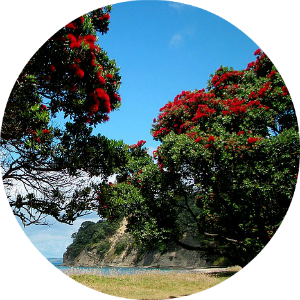
- Pōhutukawa, northern and southern rātā all have heavy, hard, strong wood that was often used in ship-building in early times in New Zealand
- Pōhutukawa and rātā make fine bush honey
- Māori have traditionally had a range of medicinal uses for both pōhutukawa and rātā. Uses include dysentery cures, stopping bleeding and remedies for coughs and colds
- Early Māori also used the flowering of pōhutukawa as a seasonal sign that kina were fat and ready to eat!
- There are several different ways to distinguish between a pōhutukawa and a rātā tree. One is to look at the leaves. Pōhutukawa leaves are generally larger and darker green than northern rātā and can have slightly rolled edges.
- The underside of a pōhutukawa leave has fine white hairs whereas the northern rātā leaf is glossy on both sides. Northern rata leaves also has a small notch in the tip.
- Hybridisation between pōhutukawa and northern rata can make identification difficult. Hybridisation is common and populations can be found on the shores of the Rotorua lakes and on Rangitoto Island. Some hybrids have been developed by the nursery industry, ‘Mistral’ (northern rātā x pōhutukawa) being a good example.
- In the past these trees were favourites for firewood!
- Pōhutukawa is considered a weed in South Africa. While we in New Zealand go to great lengths to protect the tree, it has been listed as a serious alien invader in South Africa. Stands of impenetrable pōhutukawa grow at the south-western tip of the country, demonstrating the importance of planting trees in their natural environments rather than introducing them to other places
- A mature rata becomes heavily burdened with lianes (vines) and epiphytes such as Freycinetia and astelia, as well as ferns and mosses. The weight of these plants finally result in old rata collapsing during storms, clearing the way for new trees to grow from the forest floor
- A mature pōhutukawa has a different structure to rata. Generally they are multi trunked, with spreading branches. A northern rata is generally a more upright tree.

- All the relatives of pōhutukawa and rātā within the Pacific Rim originated from New Zealand up to 10 million years ago. The wind dispersed the tiny seeds thousands of kilometres
- A pōhutukawa tree flower will have more stamen, so a denser, more prolific flowers. Northern rata has less, southern rātā, less again.

